For a country that has excelled in the history of the ICC Cricket World Cup, triumphing twice (1983 and 2011) and being the runners-up once (2003), in addition to reaching the semifinals twice (1987 and 1996), it is a Herculean job to handpick the best XI among a horde of celebrated names.What, however, makes my effort slightly easier is the fact that a surprisingly large number of Indian cricket legends have not played at the highest echelon of One Day Internationals enough to come into consideration. Among those who have, I’ve taken into account only World Cup matches played for India and the criterion that I’ve resorted to is that the concerned cricketer must have featured in a minimum of 15 World Cup innings.The implications of this criterion are that quite a few cricketers, especially those playing in the 1970s who didn’t feature in more than a single edition of the tournament, have to miss out. Also, the following XI comprises of only the best performers in World Cups for India and not necessarily the best combination to field. Changes, of course, can and should be implemented according to playing conditions.Any improvisation or change in the line-up as the reader may deem fit, is invited in the comments section below.
#1 Virender Sehwag
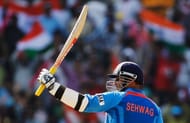
Matches: 22
Runs: 843
Average: 38.31
As a quintessential top-order batsman, Virender Sehwag is considered one of the most destructive openers to have wielded the willow. Relying solely on hand-eye coordination, he blunted attacks with nonchalant strokeplay and intimidated opponents into submission. Despite his lack of feet movement and defensive challenges, Sehwag has been tremendously successful in all formats of the game.
The belligerence that oozed from his expansive drives on the up and his fondness for chipping short-pitched deliveries over the third man for sixes were enough to demoralize the opposition skipper and nullify any threat that bowlers may possess. It was because of former India captain Sourav Ganguly’s mastermind that Sehwag was moved up the order where he ultimately ended up as one of the most feared batsmen in modern day cricket.
The impulsive aggression and lack of copybook technique, however, made Sehwag inconsistent quite often. His nonchalant wielding of the willow which materialized into sheer entertainment for Indians and agony for Bangladesh during his 175 at Dhaka in 2011 World Cup appeared logically ridiculous at times when he threw away his wicket at crisis situations.
#2 Sachin Tendulkar
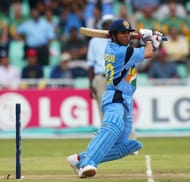
Matches: 45
Runs: 2278
Average: 56.95
A handsome no-brainer, this. The love story between Sachin Tendulkar and ICC World Cups is a tale that’s pretty much known to everybody who follows the game. 6 centuries (two each in 1996 and 2011 while one each in 1999 and 2003) and 15 half-centuries in 5 tournaments is evidence enough to the kind of affection the man nurtures for the highest stage of ODI cricket.
With 2278 runs from 45 World Cup matches, Tendulkar sits leagues ahead of the next highest run-scorer Ricky Ponting (1743 runs in 46 matches). He barely misses out on the top 10 list of highest individual scores in World Cup matches with 152 against Namibia on February 23, 2003.
There’s more to the Sehwag-Tendulkar combination than merely ruthlessness of two of India’s greatest openers. Being the man who catapulted cricket to the status of religion in the subcontinent, Tendulkar remains the reliable name that every skipper would look up to at the hour of crisis. Apart from his precise drives and copybook technique, Tendulkar’s experience and calming presence make him absolutely indispensable to any side.
#3 Sourav Ganguly (captain)
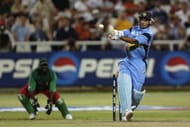
Matches: 21
Runs: 1006
Average: 55.88
Former Indian skipper Sourav Ganguly’s abilities of reading the game accurately and marshalling his resources accordingly have fetched unanimous acclamation from around the world. As a tactical genius who believed in will-power and fighting back against all odds, he changed the face of Indian cricket in more ways than one. He stands, therefore, as the undisputed leader of this all-time Indian World Cup XI.
Ganguly struck gold in his debut World Cup match against South Africa in 1999, missing out on a century by only 3 runs. He returned with the historic 183 against Sri Lanka to propel India to a match-winning 373/6 before plundering 40 in a low-scoring tie against England in the next match.
In the 2003 World Cup in South Africa, the southpaw led from the front emerging as the second highest run-scorer in the tournament only behind Tendulkar as he guided his team to 9 wins and 2 losses in 11 matches.
Ganguly was the only consistent Indian batsman with 2 half-centuries in 3 matches in the controversially profound 2007 World Cup. Regarded as one of the finest stroke-players on the offside, Ganguly’s ability to fit in perfectly at any position coupled with his fearless leadership skills make him an absolute preference for this team.
#4 Mohammad Azharuddin
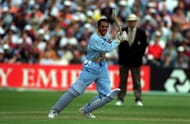
Matches: 30
Runs: 826
Average: 39.33
A regular part of the Indian playing XI, Mohammed Azharuddin had featured in four World Cups from 1987 to 1999 before being banned from the Indian team owing to match-fixing controversies. He scored 826 runs from 25 innings with eight half-centuries and a highest of 93 against Australia in the 1992 World Cup.
Azharuddin bowled economically in the second match of his debut World Cup against New Zealand but it was only in the fourth match against Australia that he shone with the bat amassing 54 runs off only 45 balls in startling knock that included 5 boundaries and a six. Despite his valiant 64 from 74 balls in the semifinals against England, India lost the match by a 35-run margin and bowed out of the tournament.
After emerging as the leading run-scorer for India in the otherwise forgettable 1992 World Cup with 332 runs in 7 matches, Azharuddin returned as the captain of the Indian team in the 1996 World Cup. He however failed to impress with a sole 72 off 80 deliveries in a 175-run partnership with Sachin Tendulkar in a losing cause. Despite his frequent failures, it was the stylish firepower that made his batting a crowd favorite.
#5 Rahul Dravid (wicket-keeper)
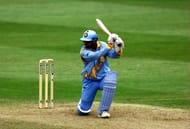
Matches: 22
Runs: 860
Average: 61.42
What stands out for Rahul Dravid in World Cups is the number of times he has remained unbeaten in his 21 innings – 7. With two centuries and six fifties, he sits atop the list of Indian cricketers with highest batting average in World Cup fixtures. The difference of more than 22 between his World Cup average and overall career average illustrates his calibre and penchant for rising up to the occasion.
Famous for his solid defense and unwavering resistance against even the world’s most potent bowling attacks, Dravid was a veteran marksman who picked up the gaps with meticulous precision and maneuvered the field with soothing elegance. He has been a part of the Indian brigade for the 1999, 2003 and 2007 World Cups, having captained the national outfit in the latter edition of the tournament.
Arguably the second best No. 3 batsman in the world after Australia’s Ricky Ponting, Dravid has been equally successful at No. 5 providing solidity in the middle order and holding fort when chips are down.
That he is as accomplished with the gloves (196 career catches and 14 career stumpings in ODIs) as with the bat serves a healthy purpose by allowing room for accommodating an extra batsman in this line-up lower down the order. Having said that, the single factor that contributed largely to selecting a part-timer for the wicket-keeper’s job is the scarcity of resources in the first place.
While Syed Kirmani and Mahendra Singh Dhoni have had nothing to talk about except a single innings each – the latter’s leadership skills being rendered unnecessary by Ganguly’s presence – Kiran More’s contributions with the bat have been mildly worse than abysmal. Farokh Engineer, belonging to the early 1970s, had played only 3 World Cup matches and Nayan Mongia had been pretty inconspicuous in the two editions he featured in.
#6 Yuvraj Singh
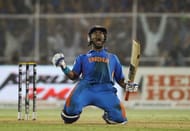
Matches: 23
Runs: 738
Average: 52.71
Wickets: 20
As he struck the winning runs for his country in the quarter finals of 2011 World Cup against Australia, Yuvraj Singh skidded onto his knees and screamed in exhilaration. It was more than just a scream though. It was an expression of pent-up angst, the declaration of fighting back in the face of physical problems. The Player of the Tournament single-handedly guided his team through to the finals where they triumphed after a span of 28 long years. It was his determination; patience and calmness that aided his team escape from many a sticky position in the tournament.
There’s more to Yuvraj than just a left-handed middle order batsman. A clean striker with the bat, an effective partnership-breaker with the ball, an acrobatic infield fielder and a reassuring face in the dressing room – Yuvraj is that X-factor which you’d want to play with, and not against. In his debut World Cup in 2003, the southpaw provided useful contribution with 4 wickets and a half-century in consecutive matches, but it was not until the 2011 World Cup that he could uncover the full potency of his part-time spin bowling.
#7 Kapil Dev
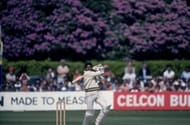
Matches: 26
Runs: 669
Average: 37.16
Wickets: 28
India’s first World Cup winning captain Kapil Dev could make any team with his bowling skills – 253 career wickets at a miserly economy of 3.71 per over. The 1983 Wisden Cricketer of the Year, however, had enough in his artillery than merely bowling. Apart from being a handy lower middle order batsman, he was equally dependable in the field, as his evident from his 71 catches in 225 matches.
The Haryana Hurricane’s unbeaten knock of 175 from 138 deliveries against Zimbabwe in the 1983 World Cup which included 16 hits to the rope and 6 over boundaries is a direct testament to his efficiency as a batsman. He steered his army to the finals with a fine display of fast bowling that vanquished the England batsmen in the semis.
Although he enjoyed sporadic successes at the 1987 World Cup with the ball, Kapil Dev was largely innocuous with the bat – a fact that he changed in the following edition where he emerged with the highest batting strike-rate at almost 125 runs per 100 balls faced. It is therefore, Kapil’s all-round abilities that make him a versatile option at No. 7 – a notch below another all-rounder in Yuvraj Singh.
#8 Manoj Prabhakar
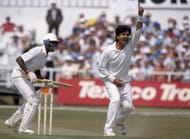
Matches: 19
Wickets: 24
Average: 26.66
Before being banned from donning national colours for his alleged involvement in the match-fixing scandal in the late 90s, Manoj Prabhakar used to be a decent right-arm medium pace bowler who failed to continue his World Cup form in bilateral encounters. With an unflattering strike-rate of just above 40 with the ball, Prabhakar certainly remains the surprise pick in this squad.
Although he retired from international cricket in ignominy after being slaughtered for 47 runs in 4 overs against Sri Lanka at his home ground in the 1996 World Cup, one deems his slower variations to be effective in between regular in and out swinging deliveries. While Zaheer Khan, Javagal Srinath and Kapil Dev are expected to push the speedometer, Prabhakar with his medium pace, offers an unusual break as a one-change bowler from one end.
The presence of two frontline seamers along with Kapil Dev and Manoj Prabhakar is what makes this team pretty hypothetical. India, for all their experiments with the squad, have seldom breached the 3 pacers-2spinners combination in the playing XI. However, records suggest that no Indian spinner apart from Anil Kumble and Harbhajan Singh have scalped 20 or more in World Cup matches – the latter faring half as decently with a strike-rate of 57.70.
#9 Anil Kumble
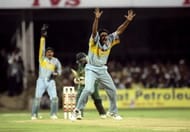
Matches: 18
Wickets: 31
Average: 22.83
Just like Zaheer Khan, Anil Kumble’s greatness lie in the fact that he turned up most vicious when the stakes were high. The legspinner from Bangalore had been a part of four World Cup squads from 1996 to 2007 although he has mostly warmed the benches, playing in only 18 matches. Despite limited opportunities, however, Kumble never flattered to deceive as he set higher standards for himself and delivered at every chance.
With an average of 22.83 that stands as only second best to Zaheer’s 20.22 among Indians at World Cups, Kumble’s exciting statistics bear direct testament to all the instances when he choked the opposition from one end forcing them to throw away wickets at the other. A wily customer who relied on bounce more than spin, Jumbo bowled wicket-to-wicket with alarming regularity.
Kumble emerged as the leading wicket-taker in the 1996 edition of the tournament with 15 victims at 18.73 apiece and also the leading catcher with as many as eight catches. He enjoyed decent amount of success pairing up with pacer Javagal Srinath often to win matches for India. In a country known for its offspinners, Kumble remains the single striking aberration who even went on to captain India in Tests towards the end of his career.
#10 Zaheer Khan
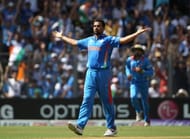
Matches: 23
Wickets: 44
Average: 20.22
The reason behind Zaheer making it into the XI ahead of the likes of Madan Lal is his potency and increased incisiveness in multination tournaments. That he has 44 wickets in 23 World Cup matches at a strike-rate of 27.1 in contrast to his overall strike-rate of 35.8 speaks volumes about why is regarded as a World Cup specialist.
Along with compatriot Javagal Srinath, he remains the 5th highest wicket-taker in World Cups. He spearheaded the Indian swing bowling department and emerged as the highest wicket-taker along with Shahid Afridi with as many as 21 scalps, interestingly, never picking up more than 3 on any occasion.
What makes the medium-pacer a ‘captain’s bowler’ is the fact that he can be economical and aggressive simultaneously and can be trusted with the ball at any part of the innings. Two of the chief reasons that contribute to Zaheer’s effectiveness is that he can read the game as well as any veteran skipper and bowl to his field accordingly, hatching plans all this while to choke the batsman into throwing away his wicket.
#11 Javagal Srinath
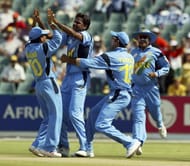
Matches: 34
Wickets: 44
Average: 27.81
Having had to miss out on a number of matches initially in his career due to the presence of veterans Kapil Dev and Manoj Prabhakar in the team, Javagal Srinath surpassed expectations when he emerged as the fastest ever Indian bowler to hit the deck and move it off the seam, tormenting batsmen on even the dustbowls in India.
Although he wavered on the expensive side for a greater part of his ODI career, Srinath was a regular wicket-taker who could provide breakthroughs at the toughest of predicaments and single-handedly rip apart opposition on his day. He came back from retirement in the 2003 World Cup, providing a lethal combination with Zaheer Khan as the leader of India’s pace attack.
It’s a pity that Srinath could not achieve his complete potential during his playing career as much because of injuries as because of sitting out of the team. Although expensive, he is the natural fast-bowler who used to wring out maximum from his strong shoulders and intimidate the opposition with pace and seam movement – clearly a fitting No. 11 for an All-time Indian World Cup team.
#12 Those who missed out
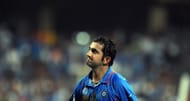
It’s not surprising that quite a few cricketers missed out because of the minimum 15 matches criterion. Let’s have a look at those who could’ve made it had they played more that they did.
Gautam Gambhir – The ravishing yet insecure-outside-off opener from Delhi was dropped from the 2007 World Cup squad, but made amends in the 2011 edition scoring a match-winning 97 in the final. In the 9 innings he played, the southpaw smashed 37 boundaries on his way to 4 fifties and a cumulative of 393 runs at a strike-rate of 85.06.
Mohinder Amarnath – The hero of the 1983 World Cup final struck a courageous 80 against the mighty West Indies in the second half of the group stage before managing a gritty 46 against England in the semis. In the final, he scalped 3/12 steering his team to the historic triumph over Vivian Richards’s men.
Navjot Singh Sidhu – The prolific right-hander from Patiala, Punjab made his mark with a less-than-run-a-ball 73 against Australia in his debut World Cup match in 1987 and went on to score three more half-centuries in the remaining group stage matches. He batted in 10 innings scoring 454 runs at a strike-rate of just above 78.
Madan Lal – Although he debuted at the 1975 World Cup, Madan Lal’s claim to fame in the big tournament was delayed till 1983 when he scalped threeagainst Zimbabwe before returning with replenished venom with a 4-wicket haul against Australia in the must-win final group match. He ended his World Cup career with 22 wickets from 11 matches at a startling average of 19.36 and a phenomenal economy of 3.66.
Brand-new app in a brand-new avatar! Download Cric Rocket for fast cricket scores, rocket flicks, super notifications and much more!
